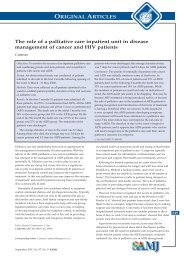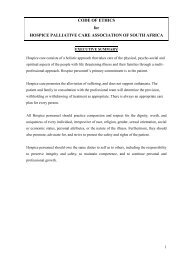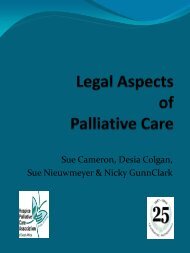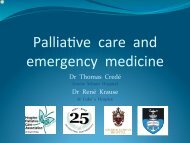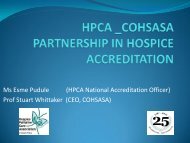Dying and The Law - Hospice Palliative Care Association of South ...
Dying and The Law - Hospice Palliative Care Association of South ...
Dying and The Law - Hospice Palliative Care Association of South ...
You also want an ePaper? Increase the reach of your titles
YUMPU automatically turns print PDFs into web optimized ePapers that Google loves.
WHEN SOMEONE DIES AT HOMEWhen someone dies at home, thecaregiver or family members need to becareful about taking care <strong>of</strong> themselvesat this time – both emotionally <strong>and</strong>physically. When someone dies, <strong>and</strong>there is no doctor or nurse there to help,certain things need to be done orsomeone trustworthy asked to assist.• Close the person’s eyes <strong>and</strong> contactsomeone who can help you – it willbe better if that person is your homebasedcarer, a nurse or a doctor.• If there is going to be a delay until adoctor, funeral director or SAPS canget to you, then the body may needcleaning.• Cover any wounds or sores, takingcare to cover your h<strong>and</strong>s with glovesor plastic bags.• Put a cloth between the legs <strong>and</strong> upunder the buttocks.• Put clean clothes on the deceasedperson, if you are able.• Remove all pillows.• Straighten the body <strong>and</strong> limbs (arms<strong>and</strong> legs).If a medical practitioner arrives he/sheneeds to give you the medical certificate<strong>of</strong> death. This will explain the cause <strong>of</strong>death. This is not the death certificate.<strong>The</strong> medical practitioner will h<strong>and</strong> thedocuments to next-<strong>of</strong>-kin or to thefuneral undertaker. If a medicalpractitioner is not available then youshould contact a funeral company assoon as possible as you will needsomeone to help you remove the body<strong>and</strong> prepare it for burial. In rural areasthe traditional leader or SAPS can assistin dealing with the removal <strong>of</strong> a deceasedperson.<strong>The</strong> funeral director may need thefollowing documents from you:• the deceased’s ID document or• an <strong>of</strong>ficial document that will showthe deceased’s date <strong>and</strong> place <strong>of</strong>birth <strong>and</strong> place <strong>of</strong> death• details <strong>of</strong> any hazardous work thatthe deceased was employed to do –if relevant• details <strong>of</strong> any funeral policies, burialsocieties or pre-paid plans• the medical certificate issued by themedical practitioner.NotesChapter 12 | <strong>Dying</strong> <strong>and</strong> <strong>The</strong> <strong>Law</strong>191




